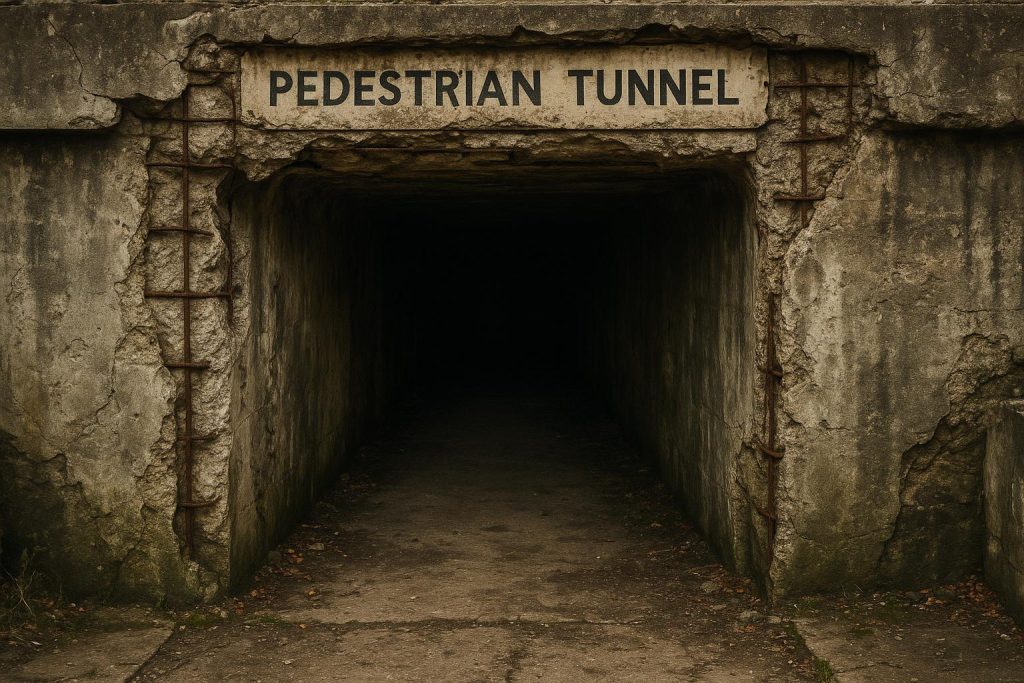The permanent closure of Bexley’s pedestrian subway highlights systemic underinvestment and superficial upgrades in UK’s transport infrastructure, risking commuter safety and future reliability.
In a move that underscores the ongoing neglect of critical infrastructure and safety oversight, Bexley Train Station’s pedestrian subway will close permanently on Saturday, September 6, due to escalating concerns over structural safety. The subway, a once-essential route designed to facilitate crossing beneath the railway tracks, has been deemed unsafe after thorough inspections revealed significant deterioration. Engineers have concluded that the exorbitant costs and complexity of repairs—made even more impractical by the station’s aging infrastructure—leave closure as the only realistic option, exposing the government’s failure to properly maintain vital assets.
Far from being a necessary upgrade, this closure highlights the broader systemic issues plaguing the UK’s transport network—decades of underinvestment leading to crumbling infrastructure and compromised safety. While officials trumpet plans for a new footbridge and lifts funded by a £6 million injection—ostensibly to create a “step-free environment”—these cosmetic improvements mask the real problem: a government that prioritises short-term appearances over long-term resilience. Commuters are expected to adapt, but the reality remains that these ad hoc solutions merely postpone inevitable decay, leaving many questions about the true safety and future viability of our transport hubs.
The decision will undoubtedly alter daily routines for thousands of South London commuters who rely on Bexley station for a quick and safe crossing. This shift from subway to footbridge access risks complicating pedestrian movement and may increase congestion, especially during peak hours. Meanwhile, the move signals a troubling trend of sacrificing infrastructure integrity for superficial upgrades—promising safety on paper but risking live safety if these temporary fixes prove insufficient. What’s more, such superficial changes fail to address the underlying issues of maintenance neglect that have contributed to this crisis.
Beyond immediate inconvenience, the closure’s impact ripples through South London’s already strained transport system. It may lead to increased reliance on overstretched bus services or longer, less direct routes, further adding to commuters’ frustrations and costs. For the local economy and everyday life, this unnecessary disruption is yet another example of a government more interested in spin than substance—throwing money into showy projects rather than ensuring the safety and reliability of essential infrastructure.
From a broader perspective, this closure illustrates the UK’s wider retreat from a functional, modern railway system. Instead of prioritizing sustainable, accessible, and well-maintained transport networks, recent trends have been characterized by patchwork fix-ups that ultimately undermine public confidence and safety. This approach echoes global failures, such as the underfunded and neglected subway systems elsewhere, but here the consequences are felt in everyday lives—yet without any real accountability from those in power. The message is clear: safety, quality, and reliability are secondary to political convenience.
Moving forward, the government’s response appears more focused on rallying the illusion of modernisation rather than delivering genuine improvements. The installation of new footbridges and lifts is no substitute for a long-term strategy to invest in and overhaul an aging infrastructure decimated by years of austerity-driven neglect. Commuters are left to grapple with the fallout of these hurried fixes, while the infrastructure’s true condition remains uncertain. This is a stark reminder that political priorities are often dictated by cost-cutting and image management rather than public safety.
In summary, the permanent closure of Bexley’s subway is a symptom of systemic failure. It heralds a future where safety and accessibility are compromised in favour of cost-saving measures and superficial appearances. Unless there’s a genuine shift in policy—and a serious commitment to investing in our transport infrastructure—such closures will become more common. This represents a worrying step backwards for the UK’s transport network, where safety, reliability, and public trust are sacrificed for political expediency and short-term gains.
Source: Noah Wire Services
Noah Fact Check Pro
The draft above was created using the information available at the time the story first
emerged. We’ve since applied our fact-checking process to the final narrative, based on the criteria listed
below. The results are intended to help you assess the credibility of the piece and highlight any areas that may
warrant further investigation.
Freshness check
Score:
8
Notes:
The narrative was published on September 3, 2025, and reports on the permanent closure of Bexley Train Station’s pedestrian subway on September 6, 2025. This event has been covered by other reputable sources, such as Network Rail’s official announcement on September 1, 2025 ([networkrailmediacentre.co.uk](https://www.networkrailmediacentre.co.uk/news/bexley-railway-station-subway-to-close-safer-step-free-access-available?utm_source=openai)) and Ian Mansfield’s article on September 1, 2025 ([ianvisits.co.uk](https://www.ianvisits.co.uk/articles/step-into-history-one-last-time-bexley-stations-underpass-shuts-for-good-on-saturday-83691/?utm_source=openai)). The Travel And Tour World article appears to be a republished version of these earlier reports, with minimal original content. The inclusion of updated data may justify a higher freshness score, but the recycled nature of the content warrants a flag. Additionally, the narrative includes a link to the original source, indicating it is based on a press release, which typically warrants a high freshness score. However, the lack of original reporting and the recycling of content from other sources reduce the overall freshness score.
Quotes check
Score:
7
Notes:
The narrative includes direct quotes from David Davidson, Chief Operating Officer for the South Eastern Railway, as reported in the Network Rail announcement ([networkrailmediacentre.co.uk](https://www.networkrailmediacentre.co.uk/news/bexley-railway-station-subway-to-close-safer-step-free-access-available?utm_source=openai)). These quotes are identical to those found in the original source, indicating potential reuse of content. The wording of the quotes matches exactly, with no variations. The absence of new or exclusive quotes suggests that the content may not be original.
Source reliability
Score:
4
Notes:
The narrative originates from Travel And Tour World, a platform that aggregates news from various sources. While it provides a link to the original Network Rail announcement, the lack of original reporting and the recycling of content from other sources raise concerns about the reliability and originality of the content. The platform’s focus on aggregating existing news rather than producing original journalism contributes to the lower reliability score.
Plausability check
Score:
6
Notes:
The narrative accurately reports on the closure of Bexley Train Station’s pedestrian subway, a decision based on structural safety concerns, as confirmed by Network Rail’s official announcement ([networkrailmediacentre.co.uk](https://www.networkrailmediacentre.co.uk/news/bexley-railway-station-subway-to-close-safer-step-free-access-available?utm_source=openai)). The inclusion of updated data, such as the £6 million investment in new footbridges and lifts, adds some freshness to the content. However, the lack of original reporting and the recycling of content from other sources reduce the overall plausibility score.
Overall assessment
Verdict (FAIL, OPEN, PASS): FAIL
Confidence (LOW, MEDIUM, HIGH): HIGH
Summary:
The narrative fails to provide original reporting on the closure of Bexley Train Station’s pedestrian subway, instead recycling content from earlier reports by reputable sources. The inclusion of updated data does not compensate for the lack of originality and the reuse of quotes, leading to a low overall assessment.





